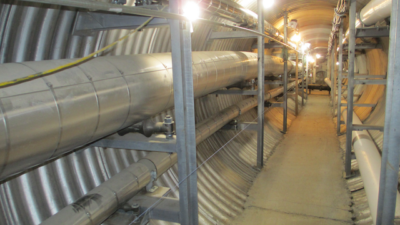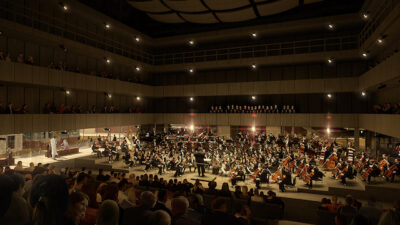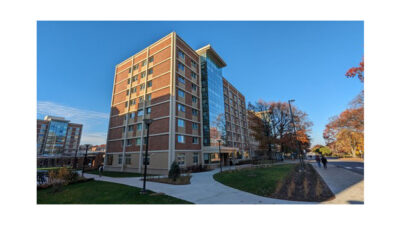Directional sound technology is a quantum leap for fire-emergency egress systems. Along with standard audible-visible devices, directional sounders allow designers to specify “audible exit signs” or map egress routes to the nearest exit.
Using broadband, multi-frequency sound, directional sound is adaptable for two different applications. In a Type 1 installation, the intent is to place a sounder near each exit, stairwell or area of refuge as an audible cue for locating an egress during an emergency.
Type 2 uses directional sounders to guide occupants along an escape route. Type 2 installations, like Type 1, require sounders at exits and stairwells but also use additional sounders to create a path by producing noise patterns that become progressively faster as a person nears an exit. For this more complex egress system to be effective, sounder placement must align with a direct egress path that does not lead evacuees in a circular route or into a dead end.
In buildings with floors above or below grade, sounders emitting upward- or downward-sweeping tone pulses alert occupants they are approaching a stairway and need to proceed, respectively, either down or up. This function is for both Type 1 and Type 2 installations. A separate tone identifies areas of refuge.
When creating a Type 2 path that turns or changes direction, it’s preferable for the sounder to be located within two ft. past the turn. Generally, sounder spacing of 50 to 80 ft. provides the necessary sound output to alert occupants they should move from one sounder to the next along the escape route. Such spacing will result in occupants entering the audible zone of one sounder a couple of steps after passing the previous audible zone. At some junctions, such as self-closing cross-corridor doors, an additional directional sounder may be needed to indicate that the path continues beyond the doors.
Under some circumstances, usually in older buildings, windows leading to fire escapes are often still considered a part of the required exit system. Therefore, they should be marked with directional sounders to supplement visual signage. However, in schools and day-care centers, windows designated as “windows for rescue” are intended only for firefighters to assist in evacuation and not for occupants to use on their own. At such locations, sounders serve no practical purpose. Also, sounders should not mark windows in apartments and private residences.
The effectiveness of directional sound overcomes two phenomena common in building evacuations. First, occupants tend to exit a building via the same door as they entered, often bypassing other exits. Second, people seldom consider the information conveyed by visual exit signs. As a result, directional sound technology offers significant advantages over visual way-finding aids, which can be difficult to see—and therefore, easy to miss—in smoke-filled environments.
Additionally, directional sounders can lead people of all languages to exits using broadband sound, and the audible cues can direct people with visual impairments.
Directional sound is the only technology proven to overcome all of these obstacles. With Type 1 installations, and the promise of more advanced way-finding with Type 2 installations, engineers now have new tools to better protect life.
Directional sound advantages
Can lead people of all languages to exits using broadband sound
Audible cues can direct people with visual impairments
Is especially helpful in smoke-filled environs, where visual aids are obscured
Can produce noise patterns that become progressively faster as a person nears an exit



